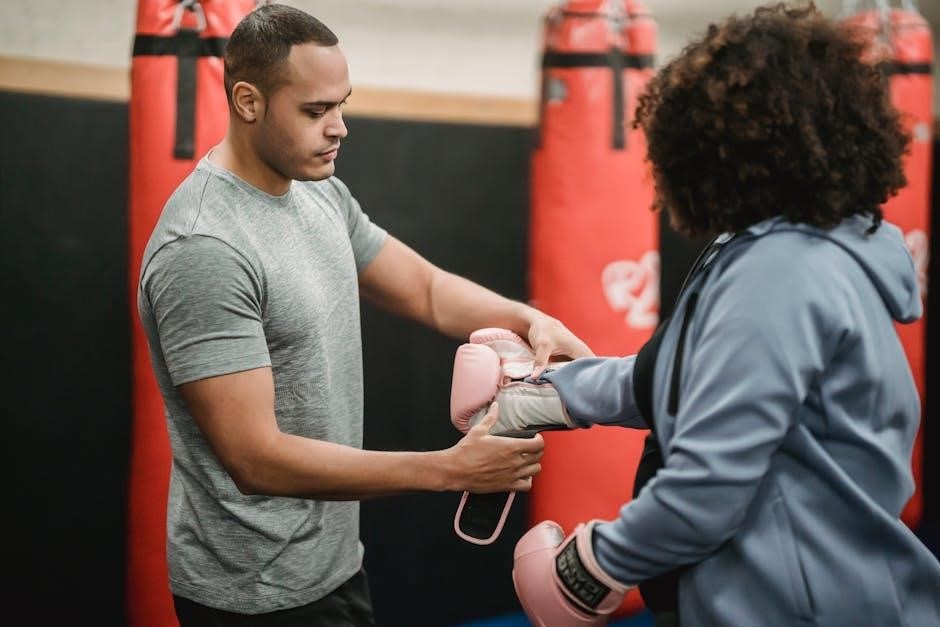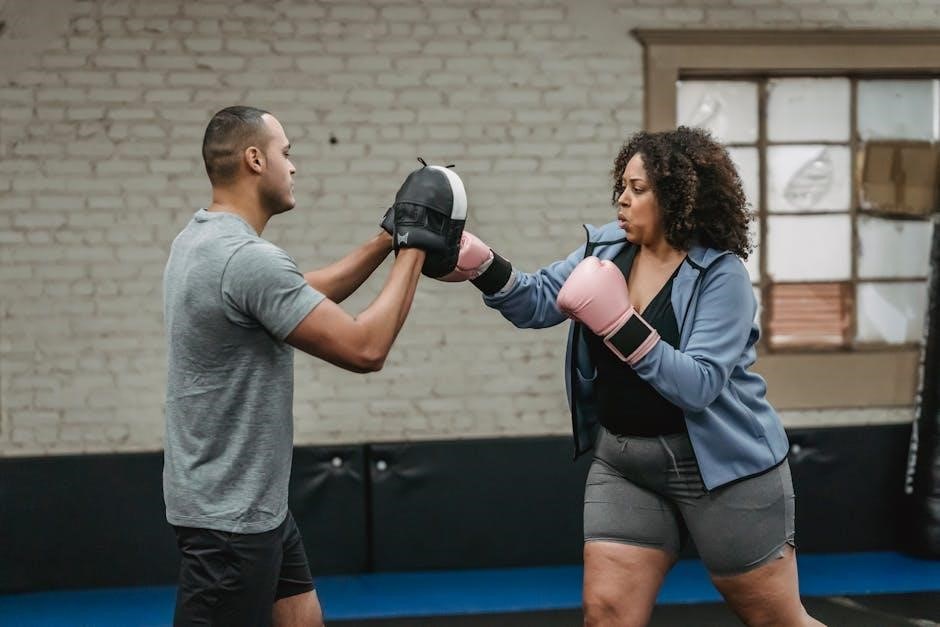Welcome to our comprehensive guide on choosing the right boxing gloves! This guide helps you understand glove sizes, weights, and how to ensure a proper fit for optimal comfort and protection during training or competition․

Understanding Boxing Gloves Basics
Boxing gloves range from 8 oz to 18 oz, with each weight offering varying levels of padding and protection for different training purposes and skill levels․
2․1․ How Boxing Gloves Are Measured
Boxing gloves are typically measured in ounces, ranging from 8 oz to 18 oz, with most common sizes being 10 oz, 12 oz, 14 oz, and 16 oz․ The weight reflects the amount of padding, which determines protection and suitability for activities like training, sparring, or competition․ Gloves are also sized by hand circumference, ensuring a snug fit that allows for proper movement and comfort during use․
2․2․ Common Boxing Glove Sizes and Weights
Common boxing glove sizes range from 8 oz to 18 oz, with 10 oz, 12 oz, 14 oz, and 16 oz being the most popular․ Lighter gloves (8-10 oz) are ideal for competition and speed training, while heavier ones (14-18 oz) offer more padding for sparring and heavy bag work․ Each weight class is designed to suit different training needs, ensuring optimal protection and performance for various boxing activities and skill levels․
How to Measure Your Hand for Boxing Gloves
Measure your dominant hand’s circumference just below the knuckles, including the thumb but excluding the wrist, to determine the ideal glove size for a snug fit․
3․1․ Measuring Hand Circumference
To measure your hand circumference, wrap a flexible tape measure snugly around your dominant hand, just below the knuckles, including the thumb but not the wrist․ Ensure the tape is tight enough to compress the skin slightly but not so tight that it restricts movement․ This measurement will help determine the correct size of your boxing gloves, ensuring an optimal fit for training or competition․
3․2․ Understanding Weight Classes and Hand Size
Boxing glove weight classes are designed to match your hand size and training needs․ Heavier gloves (14oz-18oz) are ideal for larger hands and heavier athletes, providing extra padding for sparring․ Lighter gloves (8oz-12oz) suit smaller hands and lighter weight classes, offering better dexterity․ Ensure your glove weight aligns with your weight class and activity type for optimal protection and performance during training or competition․
Choosing the Right Weight for Your Training
Selecting the correct weight for your boxing gloves ensures proper protection and performance․ Lighter gloves (8-12oz) are ideal for speed and technique, while heavier options (14-18oz) provide extra cushioning for sparring and heavy bag work․
4․1․ Training and Sparring Gloves
Training and sparring gloves are essential for both practice and partner drills․ They typically range from 12oz to 16oz, offering a balance of protection and flexibility․ These gloves are designed to absorb impact during intense sessions, ensuring hand safety while allowing for precise movements․ The 12oz gloves are ideal for lighter sparring, while 14oz and 16oz gloves provide additional padding for heavier training․ Choosing the right weight ensures optimal performance and protection․
4․2․ Heavy Bag and Pad Work Gloves
Heavy bag and pad work gloves are designed for striking drills and building endurance․ They typically range from 10oz to 14oz, offering less padding than sparring gloves but more flexibility for speed and precision․ These gloves are ideal for solo training, allowing boxers to focus on technique and power․ The lighter weight enhances hand speed, while the compact design provides adequate protection for repetitive impact․ They are perfect for intense bag work and pad drills, helping to improve reflexes and striking accuracy․
4․3․ Competition and Fight Gloves
Competition and fight gloves are designed for actual bouts, typically weighing between 8oz to 12oz․ They offer minimal padding for lighter weight and faster movements, providing a firm punch impact․ These gloves are used in professional matches, ensuring compliance with regulations․ They have a snug fit to prevent hand movement, prioritizing performance over training comfort․ Fight gloves are essential for fighters needing precision, speed, and adherence to competition standards, making them a crucial choice for athletes in the ring․
Boxing Glove Size Chart
Our chart provides a clear overview of sizes, weights, and activities․ It helps you find the perfect fit based on your training needs and hand measurements․
5․1․ Weight Ranges and Corresponding Sizes
Boxing gloves are categorized by weight, typically ranging from 8 oz to 18 oz․ Lighter gloves (8-10 oz) are ideal for competitions, while heavier ones (14-18 oz) suit sparring and training․ The size corresponds to the weight, ensuring proper protection and comfort․ A 12 oz glove is a popular choice for most boxers, offering a balance between protection and flexibility․ Always refer to the size chart to match your needs effectively․
5․2․ Size Recommendations by Activity
Choosing the right glove size depends on your activity․ For pad work and light training, 10 oz gloves are ideal․ Sparring requires more protection, so opt for 12 oz or 14 oz․ Heavy bag work benefits from 14-16 oz gloves for shock absorption․ Competitions typically use 8-10 oz, while larger sizes like 18 oz are best for protection during intense training․ Match the glove size to your activity for optimal performance and safety․

Gender-Specific and Youth Boxing Gloves
Boxing gloves are tailored for men, women, and youth, with sizes ranging from 8 oz to 18 oz․ Men’s gloves are typically 12-16 oz, women’s 8-12 oz, and youth sizes start at 6 oz, ensuring a snug, protective fit for all training needs;
6․1․ Men’s Boxing Gloves Sizes
Men’s boxing gloves typically range from 12 oz to 16 oz, with 12 oz used for lighter training and 16 oz for heavy sparring․ Sizes correspond to hand circumference and weight, ensuring a snug fit․ Proper sizing is crucial for hand protection and performance, with larger gloves offering more padding for heavy bag work and sparring sessions․
6․2․ Women’s Boxing Gloves Sizes
Women’s boxing gloves are designed for a snug, comfortable fit, typically ranging from 8 oz to 12 oz․ These sizes accommodate smaller hand sizes while providing adequate protection․ The 10 oz and 12 oz gloves are popular for training and sparring, ensuring support without restricting movement․ Proper fit is essential to prevent injury and enhance performance during workouts or competitions․
6․3․ Youth and Kids’ Boxing Gloves Sizes
Youth and kids’ boxing gloves are designed for smaller hands, typically ranging from 6 oz to 8 oz․ These sizes are ideal for young athletes, offering protection and comfort while allowing for proper hand movement․ The smaller weights are suitable for training and sparring, ensuring safety and dexterity․ Proper fit is crucial to prevent injury and support skill development in younger boxers․ Always consult a size chart or coach to find the best fit for growing hands․

Factors Affecting Glove Fit
Padding thickness, wrist strap tightness, and hand circumference significantly impact glove fit․ Proper fit ensures protection, comfort, and mobility during training or competition․
7․1․ Padding and Protection
Premium padding materials like gel and foam enhance protection, absorbing impact during strikes․ Thicker padding in heavier gloves offers superior cushioning, making them ideal for sparring and heavy bag work․ Proper padding ensures hand safety, reducing injury risks while allowing optimal performance․ The right balance of padding and weight is crucial for both training and competition, ensuring durability and comfort․ Padding thickness varies by glove type, tailored to specific training needs․
7․2․ Wrist Strap and Closure Systems
A secure wrist strap ensures stability, preventing gloves from shifting during use․ Closure systems like Velcro or laces provide adjustable fits, crucial for wrist support and glove retention․ Properly fastened gloves enhance performance and safety, while easy adjustments allow for comfort during training․ The design of the wrist strap and closure directly impacts glove stability, making them essential considerations when selecting the right pair for your needs․
7․3․ Hand Circumference and Finger Length
Accurate measurements of hand circumference and finger length are crucial for proper fit․ Measure around the widest part of your hand, just below the knuckles, to determine size․ Finger length affects how snugly the gloves fit, ensuring comfort and control․ A glove that fits well balances hand and finger dimensions, providing effective protection without restricting movement during training or competition․

Materials and Their Impact on Size
Leather and synthetic materials affect glove sizing differently․ Leather gloves may fit snugly, while synthetic materials can offer a slightly looser fit, impacting overall comfort and protection․
8․1․ Leather vs․ Synthetic Gloves
Leather and synthetic gloves differ significantly in fit and performance․ Leather gloves tend to mold to your hand over time, offering a snug, durable fit, while synthetic gloves provide a looser, more forgiving feel․ Leather is often preferred for its breathability and longevity, making it ideal for heavy training․ Synthetic materials, however, are easier to clean and more affordable, suiting casual or beginner boxers․ Both materials impact sizing, so choosing the right one ensures optimal comfort and protection during training or competition․
8․2․ Gel, Foam, and Other Padding Materials
Gel, foam, and other padding materials significantly affect glove fit and performance․ Gel padding offers superior shock absorption and maintains shape, reducing long-term wear․ Foam padding is lighter and breathes better, making it ideal for speed and agility․ Hybrid models combine materials for balanced protection and mobility․ Thicker padding may require sizing up to ensure a comfortable fit, while thinner padding allows for a snug feel without compromising hand movement or dexterity during training sessions․

Common Mistakes to Avoid
Common mistakes include choosing gloves too tight or too loose, ignoring hand circumference, and selecting the wrong weight for the activity, leading to discomfort or injury․
9․1․ Choosing Gloves That Are Too Tight
Choosing gloves that are too tight can restrict hand movement and blood circulation, causing discomfort and increasing the risk of injury․ Tight gloves may lead to cramped fingers, reduced dexterity, and limited padding effectiveness․ This can hinder performance during training or sparring and potentially cause long-term damage to hands and wrists․ Always ensure a snug but comfortable fit to maintain proper mobility and protection․
9․2․ Choosing Gloves That Are Too Loose
Choosing gloves that are too loose can compromise protection and performance․ Loose gloves allow excessive hand movement, leading to improper fist formation and reduced striking accuracy․ They may also shift during training, causing discomfort and potential injuries․ Additionally, loose gloves can fail to provide adequate padding, increasing the risk of hand damage․ Always opt for a snug, secure fit to ensure proper protection and control during training or competition․
Choosing the right boxing gloves is a crucial decision for any boxer; By understanding glove sizes, weights, and proper fit, you can enhance your performance and protect your hands․ Remember, a snug fit ensures protection without restricting movement․ Use our guide to make an informed choice, whether for training, sparring, or competition; The right gloves will be your trusted partner in achieving your boxing goals․

Additional Resources
Explore detailed glove size charts and manufacturer-specific guides to refine your selection process․ Check out our recommended tools for precise measurements and expert advice․
11․1․ Glove Size Guides and Charts
Refer to our comprehensive boxing gloves size charts for precise measurements․ These charts outline weight ranges, hand sizes, and activity-specific recommendations․ Whether you’re a beginner or an advanced fighter, our guides ensure the perfect fit․ Use our detailed tables to match your weight class with the ideal glove size, from 8oz to 18oz․ Find your optimal fit effortlessly with our easy-to-follow charts tailored for training, sparring, or competition․
11․2․ Manufacturer-Specific Sizing Tools
Different brands offer unique sizing tools to help you find the perfect fit․ For example, Everlast and Title provide detailed size charts tailored to their glove models․ These tools often include weight recommendations, hand circumference measurements, and activity-specific guidance․ Use these resources to ensure accuracy when selecting gloves from your preferred brand․ Manufacturer-specific guides can also highlight material differences and padding styles, making your choice more informed and personalized․